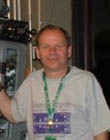|
|
 
|
|
Author
|
Topic: Wireless microphones for use in screen with CP750
|
|
|
Randy Stankey
Film God

Posts: 6539
From: Erie, Pennsylvania
Registered: Jun 99
|
 posted 06-26-2013 10:00 PM
posted 06-26-2013 10:00 PM




The best kind of wireless microphone is the kind you plug in. ![[Wink]](wink.gif)
Don't get cheap wireless mics. You definitely get what you pay for! You'll want a mic system with dual diversity. Diversity systems have two (or more) receivers inside one unit and two separate antenna inputs. The system monitors both sides and picks the one with the best signal. There's less chance of losing the signal that way because one antenna/receiver should always be able to get a signal. There are also frequency agile systems which monitor several radio frequencies to find the one with the least interference. None of these features come cheap. Expect to pay $500 to $750 (USD) per microphone/receiver set.
Seriously consider getting external antennas to mount in the theater and run the feed cables through the wall (conduit) to the booth. There are many good wireless systems, these days, but few are THAT good that they can go through walls and punch through all the electronic interference that's usually present in an average projection room. That's two antennas for a diversity system. Mount them several feet apart in an area at the rear of the auditorium. Not necessarily line-of-sight but it's often better if you do. Probably $100 (USD) for a set of antennas and mounting hardware. Coax cable to feed the antennas to the receivers is extra cost.
Also consider an antenna distribution amplifier. With a distro, you can feed four or more receivers, allowing you to run multiple transmitters and receivers on only one set of antennas. It also amplifies the signal, giving you better range and reliability. Expect to pay $750 to $1,000 (USD) for a distro.
All of this equipment usually can be mounted in a sound rack, making it all easy and convenient to set up and maintain. Outputs of these systems are often XLR microphone lines. The CP650 has XLR mic inputs for PA use. Not positive but I think the CP750 does, too. In which case, you ought to be able to just plug it in.
Spend a few bucks on a rack mountable drawer. You can keep your handheld transmitters, spare batteries, accessories and user manuals all in the drawer. They'll be safer and less likely to walk away. When you're paying $1,000 to $2,000 on a set of equipment, you don't want to lose it. The drawer will help you keep tabs on it.
Two mics, two receivers, two antennas, a distro and accessories is probably going to cost $1,500 or more, depending on dealer pricing/discounts. Again, don't go too cheap. You'll regret it!
We have Audio Technica wireless mics, receivers and distros at Mercyhurst. They work well, they're robust and, once properly installed, are virtually turnkey. Other brands are good, as well. They are mid priced. Not too cheap. Not too expensive. And I have experience using them.
| IP: Logged
|
|
|
|
Carsten Kurz
Film God
Posts: 4340
From: Cologne, NRW, Germany
Registered: Aug 2009
|
 posted 06-27-2013 04:47 AM
posted 06-27-2013 04:47 AM




Yep - 40-50metres and connection within the booth definitely needs a quality system.
Best would be a receiver/antenna mounted inside the auditorium, and a cable leading into the booth. The CP750 has a symmetrical mic input, so, even placing the receiver near the screen and feeding a 50m cable to the booth would be an option. Especially since it could be a rather cheap wired backup option. You always want backups.
I don't think you absolutely need a system with detachted antennas in this scenario. But if the money is there...
Over longer distances and within a cinema environment, you have to expect 'irregular' events. E.g. at our cinema we had a rather cheap AKG system with the receiver placed inside the booth. It never caused problems during short announcements or testing. But it happened that due to temporary installations for special events the receiver needed to be placed in slightly different locations, and that changed the situation completely. Also, when we had longer speeches, it turned out that the 'perceived' reliability suffered considerably. Once we had an event with three business people surrounding the microphone, each of them with a cell phone or pager in their pockets. Usually these things are not considered harmful, but over a longer transmission distance and if these noise sources are in close proximity to sender or receiver, they can be a real problem. I also once had considerable noise from the receiver because some idiot placed it right beside a BluRay Player. 10cm away and the noise was gone.
If you have a short dropout during a 10s announcement, hardly anyone will notice.
If a local business rents your auditorium for a presentation and their CEO has a dropout every minute, you want to run away...
We solved that issue by placing the receiver on the back wall of the auditorium and running a cable into the booth. If I had to buy a new system, I would never go with that type of equipment again. Something in the range of 500US$ up should be sufficient. Maybe a dual receiver with two mics.
- Carsten
| IP: Logged
|
|
|
|
Jim Cassedy
Phenomenal Film Handler

Posts: 1661
From: San Francisco, CA
Registered: Dec 2006
|
 posted 06-27-2013 08:32 AM
posted 06-27-2013 08:32 AM




quote: Ross McLaughlin
just wondered whether anyone had any experience with fairly reliable
(and preferably cheap) mic sets?
Since you specifically asked for info on reasonably priced wireless microphones
I can tell you that I've had excellent results with several mid-priced ($150usd)
from NADY systems. You can either buy direct from NADY or find them on e-bay.
However- - the digital equipment & xenon power supplies in modern projection
rooms tend to put out a lot of radio-frequency noise. The LAST place you want
to put your receiver is in the booth- - even if it's near the porthole.
At the distance you mention, it would be best to find a way to put your receiver
behind the screen or as close to the front of the auditorium as possible and
then run good microphone cable back to your CP-750.
In my experience UHF microphones tend to be less prone to RF noise spikes than VHF.
Be aware that the first time you use any microphone with the CP-750, you may need
to go to the MIC INPUT tab in the CP-750 setup software and establish a level
and enable or disable phantom power depending on what type of mic you're using.
You'll also need to decide which speakers your mic sound will be sent to.
Also- - just an anecdote: I have a 2nd "cheap" NADY wireless system which I
use when I need extra microphones at big events that I only paid $US80.00 for.
It performs almost as well as the other system I paid twice as much for,
the only difference I can hear is that the audio from the "cheap" system
sounds a little 'thinner' than that coming from the more expensive one.
But the only way you can hear this is if you do an A/B listening test
using the same speaker talking into both microphones at the same time.
In actual use, the slight difference in audio 'fullness' is inaudable.
Also- for some reason, at one location, there is some sort of radio frequency
signal eminating from a house located behind the theatre that jams one of
the wireless micorophone frequencies (209.15mhz) making one of the microphones
unusable. But I've only encountered this at ONE location out of dozens I've used
(or let others use) this system at. So it's just an anomoly to that location.
In short- - if you can afford an expensive system go ahead & spend the big bucks,
but there are also a lot of low-to-midrange systems that will proably work for you.
It depends a bit on your situation and who will be using your facility.
As someone else has pointed out- - if you are going to be holding conferences
involving big-wig CEO's of major corporations, you NEED to spend some money.
(and charge them accordingly for the theater rental!)
But if you're just going to be catering to smaller businesses or community groups,
where an occasional audio drop out can be a bit more tolerated, you'll probably
do just fine with a mid-range priced system.
Final word: By all means stay away from really "cheap" wireless systems.
(Anything from Tandy/Radio Shack for example)
Good Luck!
| IP: Logged
|
|
|
|
Randy Stankey
Film God

Posts: 6539
From: Erie, Pennsylvania
Registered: Jun 99
|
 posted 06-27-2013 09:08 AM
posted 06-27-2013 09:08 AM




quote: Ken Lackner
Would you not simply purchase the mounting hardware and use the antennas that would normally mount on the receiver?
The antennas supplied with the receivers are usually "rubber duck" style antennas. I have done just as you say, mount the stock antennas remotely and cable back to the receiver. It does work that way but the accessory antennas are better.
Depending on manufacturer and the frequency range the system runs on, you'll either get vertical, "Sputnik" style antennas or Yagi/LPDA antennas. You'll get much better gain and less interference. Yagi/LPDAs are more directional, too.
When we first started out, I mounted the stock antennas on the wall and they worked but, once we finally got the purpose made ones, they were noticeably better.
I once built a set of antennas out of copper-silver brazing rod. They worked pretty well but, we bought a new wireless system and got the factory made antennas. I gave my old homemade antennas to a friend who runs an amateur radio club. He now uses them for "bird dog" exercises.
I think my antennas were better but it was just as easy to buy them ready-made.
Personally, I prefer to put my receivers backstage or in the booth. Your average presenter does not understand how microphones work. Putting them near the stage just means you have to run farther (and in public view) when it becomes necessary to troubleshoot or make adjustments.
Bob Ballard came to my theater to give a lecture. He "accidentally" put his microphone on mute. When he walked out on stage and his mic didn't work, guess who everybody was looking at? It was MY fault because HE fucked up!
Subsequently, I learned to put the receivers where I can get to them easily and to tape or use safety covers over all the controls on the transmitters to prevent naive users from fiddling.
| IP: Logged
|
|
|
|
|
|
Carsten Kurz
Film God
Posts: 4340
From: Cologne, NRW, Germany
Registered: Aug 2009
|
 posted 06-27-2013 02:52 PM
posted 06-27-2013 02:52 PM




quote: Sean McKinnon
Maybe not in every house in a complex maybe just the big house. Would doing this have added significant construction cost or is it an issue of not identifying a need in the average commercial complex?
As a matter of fact, pulling in a CAT6 oder CAT7 cable is usually cheaper than dedicated mic cable, but can be used for all sorts of purposes - and it gives four channels of symmetrical audio, any direction. A roll of 100m quality cable costs less than 100US$.
I usually recommend putting in two lines of ethernet cable from the booth to one or two locations in the auditorium. In our auditorium, it runs along the speaker cables so we could use large parts of the existing wall openings and conduits.
Analog audio (bidirectional), analog video, digital audio, digital video, DMX, remote faders, format switches, RS232/RS422/RS485, networking, remote control, intercom - everything is possible with either low cost passive or medium cost active converters. The same type of cable could be used if you decide to replace your amps from the booth to behind the screen, for either multichannel digital or analog audio. IMHO, a no-brainer.
- Carsten
| IP: Logged
|
|
|
|
|
|
|
|
All times are Central (GMT -6:00)
|
|
Powered by Infopop Corporation
UBB.classicTM
6.3.1.2
The Film-Tech Forums are designed for various members related to the cinema industry to express their opinions, viewpoints and testimonials on various products, services and events based upon speculation, personal knowledge and factual information through use, therefore all views represented here allow no liability upon the publishers of this web site and the owners of said views assume no liability for any ill will resulting from these postings. The posts made here are for educational as well as entertainment purposes and as such anyone viewing this portion of the website must accept these views as statements of the author of that opinion
and agrees to release the authors from any and all liability.
|

 Home
Home
 Products
Products
 Store
Store
 Forum
Forum
 Warehouse
Warehouse
 Contact Us
Contact Us




 Printer-friendly view of this topic
Printer-friendly view of this topic





![[Wink]](wink.gif)


![[Razz]](tongue.gif)







